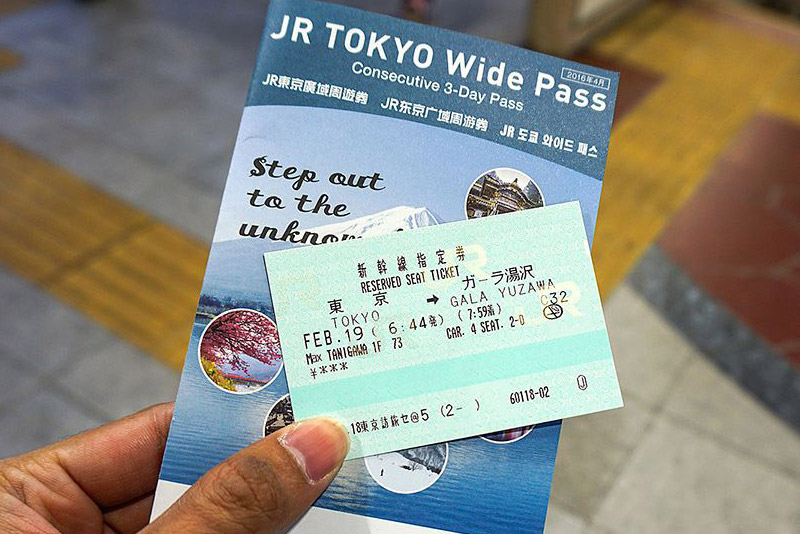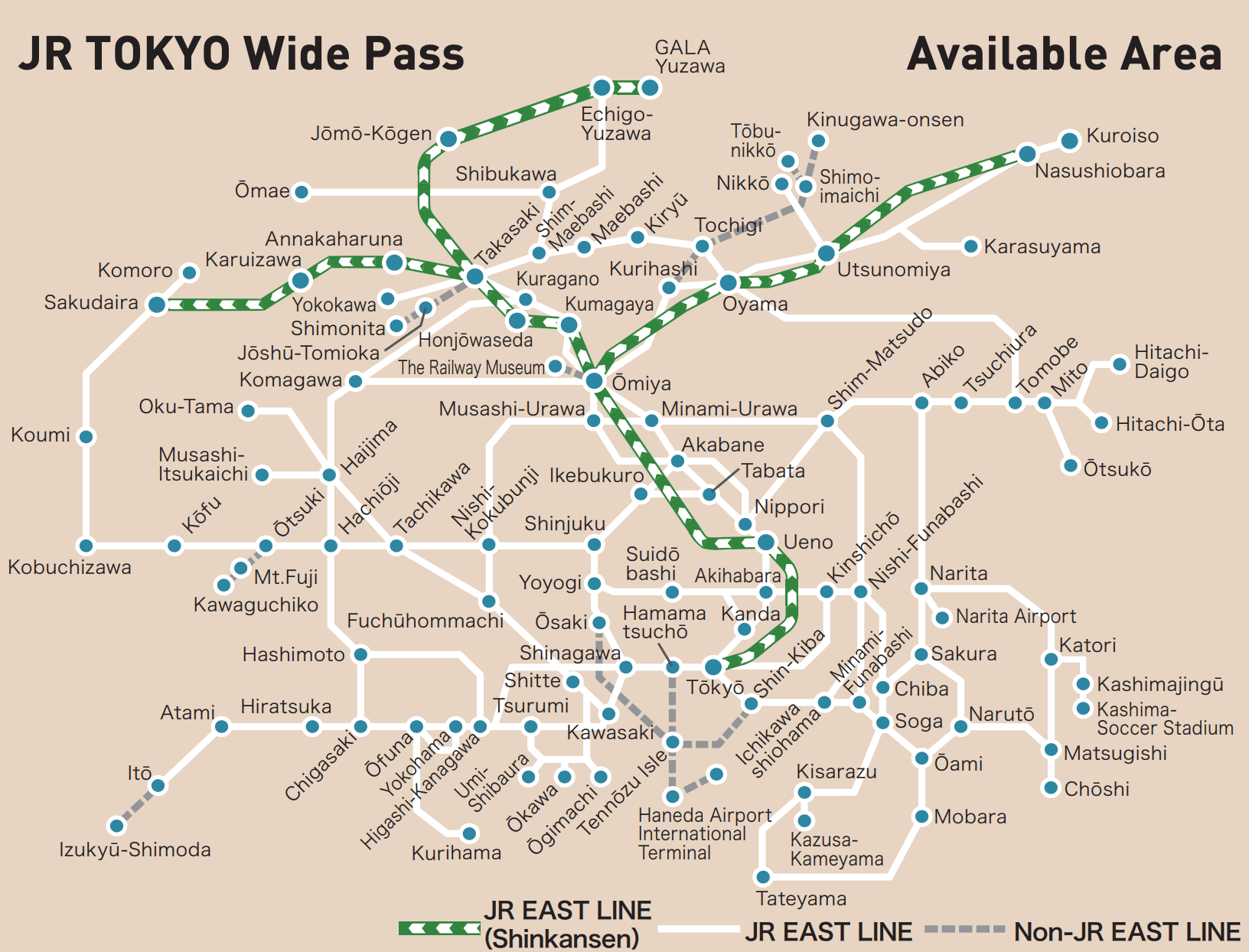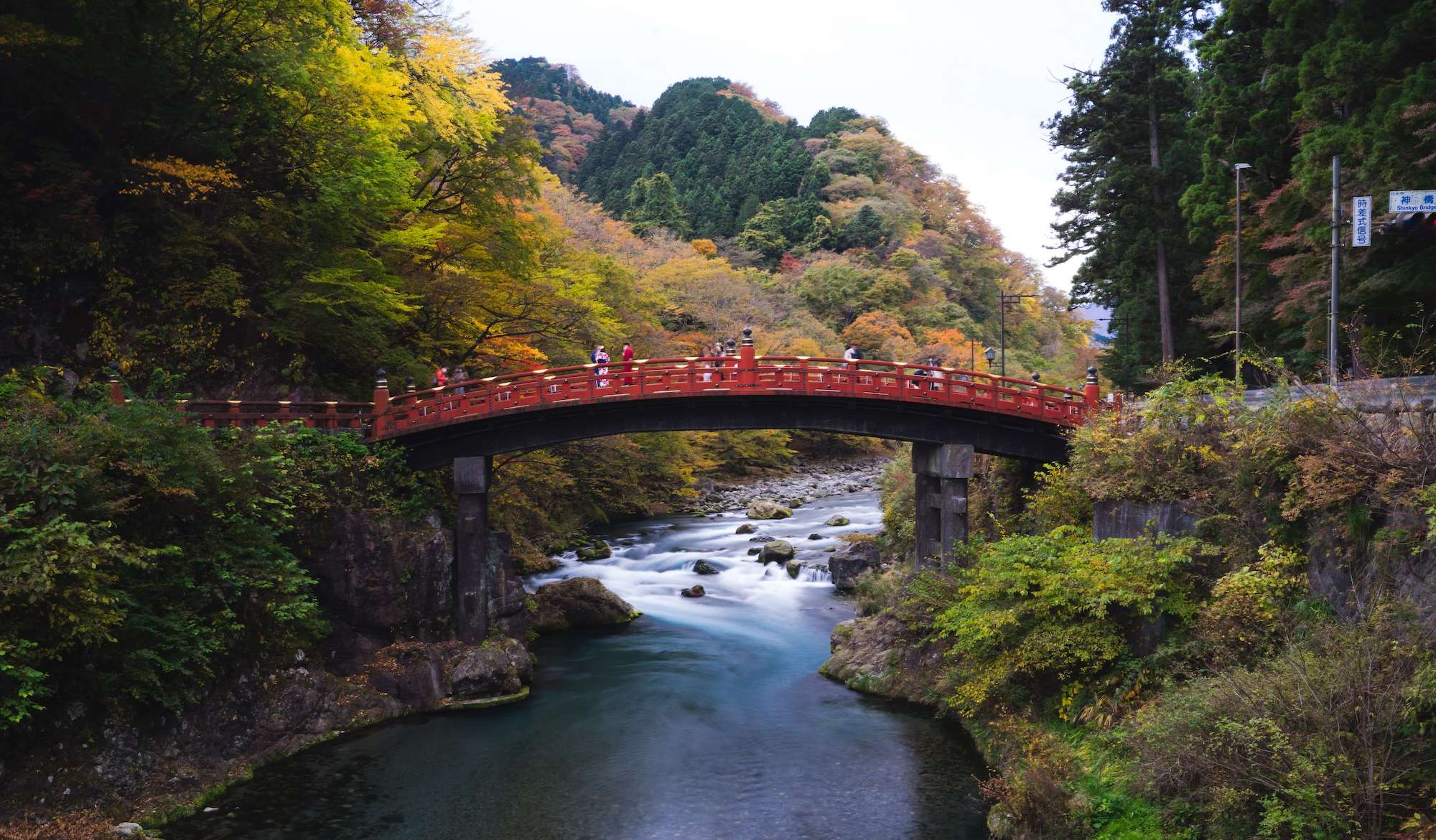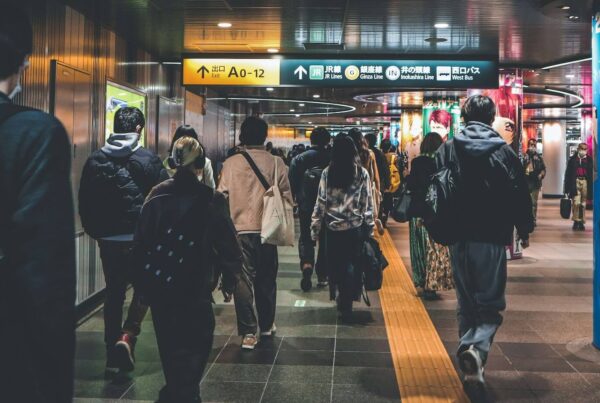Public transportation in Japan is undeniably convenient, with all kinds of trains stretching far and wide, taking passengers from city to city, prefecture to prefecture. However, if you are traveling a considerable distance, train fares add up and can get expensive real quick.
But don’t fret as there is good news! Did you know that there is a discounted train pass that you can use to travel around Tokyo and its surrounding prefectures such as Kanagawa, Chiba, and Saitama? Learn all about this economical train pass so that you can explore the Kanto region without breaking the bank!
What is the JR TOKYO Wide Pass?

Credit: wamazing.com
The JR TOKYO Wide Pass offered by JR EAST is a discounted train pass that allows unlimited travel on JR EAST trains, the Shinkansen, and Joyful Trains in the covered area for three consecutive days. The pass is exclusively available to holders of non-Japanese passports regardless of visa status. This means that even foreigners who live in Japan can take advantage of it!

Credit: wamazing.com
The JR TOKYO Wide Pass is priced at 10,180 yen for adults aged 12 years and older, and at 5,090 yen for children aged 6 to 11 years. Imagine having to spend only a little over 10,000 yen for unlimited travel on all train lines covered for three days! For instance, the round-trip fare from Tokyo Station to Nikko Station in Tochigi Prefecture is 11,360 yen (with a reserved seat on the Shinkansen). That alone is already more than the cost of the pass, so you will most definitely save a significant amount of money!
There are various ways to purchase the pass: online via the JR-EAST Train Reservation website, at ticket sales counters at JR EAST Travel Service Centers, or at ticket vending machines with passport readers. When purchasing or claiming your pass, make sure to bring your passport with you as an eligibility check needs to be done.
Another advantage of using the JR TOKYO Wide Pass is that you can make a free seat reservation ahead of time either online or at seat reservation machines placed in train stations. This way, you are sure to have a seat on the train, especially during peak seasons when there is a high likelihood of the Shinkansen being fully booked.
For more details about the pass, head on over to its website here.
For now, here is a three-day itinerary that makes the most out of the pass, which you can use as a sample when planning your own trip.
Day 1: Visit the World Heritage Sites of Nikko and taste the famed gyoza of Utsunomiya in Tochigi
If you are interested in Japanese traditions and culture, a great way to start your trip is to head north to Tochigi Prefecture.
 From Tokyo Station, take the Shinkansen to Utsunomiya, and then transfer to the local line and head to Nikko. Once you get off at Nikko Station, you can either take the bus or walk for 30 minutes or so to reach Shinkyo Bridge. The bridge, whose name literally translates to “sacred bridge,” is said to be the gateway to the Shrines and Temples of Nikko as it is situated right at the entrance to these places. It is recognized as one of Japan’s three finest bridges and is best viewed in autumn. Originally off limits to the public, you can now walk across the bridge for a small fee.
From Tokyo Station, take the Shinkansen to Utsunomiya, and then transfer to the local line and head to Nikko. Once you get off at Nikko Station, you can either take the bus or walk for 30 minutes or so to reach Shinkyo Bridge. The bridge, whose name literally translates to “sacred bridge,” is said to be the gateway to the Shrines and Temples of Nikko as it is situated right at the entrance to these places. It is recognized as one of Japan’s three finest bridges and is best viewed in autumn. Originally off limits to the public, you can now walk across the bridge for a small fee.
After which, you can continue walking to the UNESCO-recognized Shrines and Temples of Nikko, encompassing a total of 103 buildings all known for their exquisite architecture and beautiful natural surroundings. The first spot you should reach is Rinnoji Temple, said to be Nikko’s most important temple.

Credit: kosublog.com
To the west of Rinnoji is Toshogu Shrine, where Tokugawa Ieyasu of the Tokugawa Shogunate is enshrined. Inside the lavishly decorated shrine complex is the famous wood carving of the “Three Wise Monkeys” representing the proverbial saying, “see no evil, hear no evil, speak no evil.”
On the left facing the entrance to Toshogu, there is a path that leads to Futarasan Shrine, which is said to be dedicated to the deities of Nikko’s three most sacred mountains: Mt. Nantai, Mt. Nyoho, and Mt. Taro. It is important to note that Futarasan and Rinnoji were founded by the same Buddhist monk who introduced Buddhism to Nikko.

Gyotendo’s recommended set meal with pan-fried gyoza and boiled gyoza – Credit: @_0326h on Instagram
After spending the morning in Nikko, you can take the train back to Utsunomiya just in time for lunch. Known as the City of Gyoza, no trip to this city is complete without tasting the gyoza of the many restaurants here that pride themselves on their own specialties. Fair warning though, expect to see long lines of people outside the more popular restaurants waiting to have their gyoza fix as well. Wait time can last between 30 minutes to two hours depending on the day and time of your visit, as well as the popularity of the store.
If you still have time and energy to spare after satisfying your gyoza cravings, you can also visit Heiwa Kannon and the nearby Ooyaji Temple, both of which can be accessed via a 30-minute bus ride from Utsunomiya Station.
Day 2: Escape the hustle and bustle and bask in nature in Karuizawa, Nagano
For a nature retreat, head to Karuizawa in Nagano Prefecture on the second day. Karuizawa is a well-known destination for summer with cooler temperatures given its altitude.
From Tokyo Station, all it takes is a one-hour Shinkansen ride to Karuizawa. After getting off at Karuizawa Station, head to the bus stop and look for Kusakaru Kotsu Bus, which will take you to your first stop, Shiraito Falls, in about 30 minutes.

Shiraito Falls in summer – Credit: japan-guide.com
The name “Shiraito no Taki” literally translates to “white thread falls,” owing to the appearance of the waterfalls. It measures three meters high and 70 meters wide, and provides a cool and refreshing respite. There are also some food stalls right in front of the entrance to the falls where you can enjoy a variety of delicious Japanese snacks.

Credit: ikidane-nippon.com
After spending some time at the falls, you can take the same bus back down from the opposite side of where you got off earlier. Once down, get off at Old Karuizawa Ginza Street. There are also a bunch of stylish restaurants and cafes lined up if you want to sit down and enjoy a meal.
Now it is time to look for a red bus, officially known as the Karuizawa Aka Bus. Keep in mind that this bus only operates once every hour or so, with an early last trip at around 3:00 or 4:00 p.m. depending on the season, so make sure to check the schedule beforehand and plan well ahead of time to avoid wasting time. Ride it to Miharashidai, which should be the last stop.

The view from Usui Pass Observation Platform – Credit: japan-guide.com
Once you get off the bus, Kumanokotai Shrine should be on your left, a shrine located right on the prefectural border line of Nagano and Gunma. After spending some time at the shrine, walk back a little and you should reach the entrance to the Usui Pass Observation Platform. Here you can enjoy beautiful mountain views as the pass also straddles the border of the two aforementioned prefectures. Being here allows you to literally be in two places at once! How cool is that?

Kumoba Pond in autumn
– Credit: fun-japan.jp
After taking in the sights, ride the same red bus back down to Old Karuizawa Ginza Street. From here, you can walk or rent a bike to reach Kumoba Pond, which is a popular autumn spot known for its colorful fall foliage. You can also do some shopping and dining to cap off the day at Karuizawa Prince Shopping Plaza, which is located right next to the station.
Day 3: Catch panoramic views of the iconic Mt. Fuji from Lake Kawaguchi in Yamanashi
On the third day of your trip, you can travel to the Lake Kawaguchi area in Yamanashi Prefecture to see stunning vistas of Japan’s tallest mountain, Mt. Fuji.
Take the train to Otsuki Station from Tokyo, and then transfer to the Fujikyu Railway bound for Kawaguchiko Station, which the pass should cover.

Mt. Fuji from Lake Kawaguchi – Credit: @megumimiyae on Instagram
Once you get to Kawaguchiko Station, look for the Kawaguchiko Sightseeing Bus that goes around Lake Kawaguchi. Take it to Kawaguchiko Museum of Art, and when you get off, walk a little from the bus stop and you should be able to find a great spot to view Mt. Fuji. This is where a lot of the Mt. Fuji shots circulating on the internet are taken as it offers a good vantage point of the mountain all year round. You can also choose to enter the Kawaguchiko Museum of Art if you are keen to look at Mt. Fuji-related artworks.
After that, you can take the bus or walk to the base of Mt. Fuji Panoramic Ropeway that goes up Mt. Tenjo. Ride it to the top for a different perspective of Mt. Fuji, and see the heart-shaped Tenjo Bell, which is said to be a power spot for love, as well as the Usagi Jinja or “Rabbit Shrine.”

If you have not had enough of Mt. Fuji yet, another recommended spot you can visit for even more photo opportunities is the Chureito Pagoda, a five-tiered pagoda belonging to Arakura Sengen Shrine. The observation deck here offers sweeping views of Mt. Fuji and makes for superb photos with the pagoda also in frame.
Note, however, that since Mt. Fuji is only visible on clear days, it is not recommended visiting the area on bad weather days. Who would want to travel all the way there and not be able to see Fuji-san in all its glory?
Of course, there are other prefectures and places you can visit using the JR TOKYO Wide Pass. Feel free to mix and match from above or completely come up with your own! As long as the original fare for your destinations are higher than the price of the pass, then you are surely getting a bang for your buck.
GALA Yuzawa is a good stop if you are planning to take your trip sometime during the winter season. You might also want to consider Hitachi Seaside Park in Ibaraki Prefecture to admire seasonal flowers such as nemophila (baby blue eyes) in spring or kochia (summer cypress) bushes in autumn. Chiba Prefecture also has a lot of hidden gems, like Mt. Nokogiri and Cape Inubosaki, just waiting to be explored.
So, how do you plan to maximize this neat pass and which prefectures are you dreaming of visiting soon? Be sure to follow us on Facebook, Instagram, Twitter, and Pinterest for more fun stuff! Matane!

Aree Anas
Originally from the Philippines, Aree called Japan her second home for a long time before making a permanent move in 2015. Traveling, savoring great food, and conquering extreme roller coasters are just some of the things she loves to do. Always up for new adventures and experiences, she seeks to share her knowledge of Japan through her writing.






